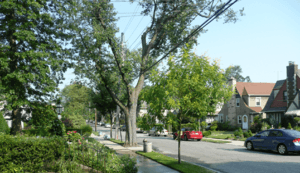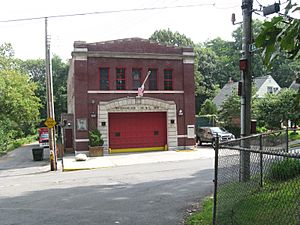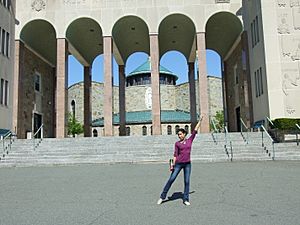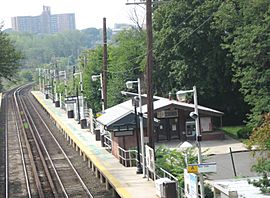Douglaston–Little Neck, Queens facts for kids
Quick facts for kids
Douglaston–Little Neck
|
|
|---|---|
|
Neighborhood of Queens
|
|
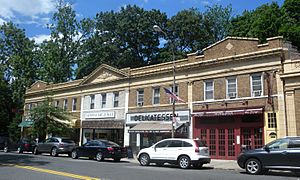
A block of shops on Douglaston Parkway; the National Art League occupies part of this block
|
|
| Country | |
| State | |
| City | New York City |
| County/Borough | Queens |
| Community District | Queens 11 |
| Founded by | George Douglas |
| Population
(2010)
|
|
| • Total | 17,823 |
| Economics | |
| • Median income | |
| Time zone | UTC−5 (EST) |
| • Summer (DST) | UTC−4 (EDT) |
| ZIP Codes |
11362, 11363
|
| Area codes | 718, 347, 929, and 917 |
Douglaston–Little Neck is a friendly neighborhood in the northeastern part of Queens, one of New York City's five boroughs. It's located on the North Shore of Long Island. To the east, it borders Great Neck in Nassau County. To the south, you'll find Glen Oaks, and to the west is Bayside.
This neighborhood has two main parts. Little Neck is usually the area east of Marathon Parkway or north of Northern Boulevard. Douglaston covers the rest of the neighborhood. Sometimes, these areas might overlap a bit. Douglaston–Little Neck feels less like a busy city and more like a suburban town. It's similar to nearby places in Nassau County, like Great Neck.
The area is also known for its historical groups, like the Douglaston Civic Association. There are two special historic districts, Douglas Manor and Douglaston Hill. Two houses, Allen-Beville House and Cornelius Van Wyck House, are also listed as important historical sites.
Douglaston–Little Neck is part of Queens Community District 11. Its ZIP Codes are 11362 and 11363. The New York City Police Department's 111th Precinct keeps the area safe.
Contents
- Exploring Douglaston–Little Neck's Geography
- A Look at Douglaston–Little Neck's History
- Who Lives in Douglaston–Little Neck?
- Community Life and Fun Activities
- Shopping and Food
- Safety and Services
- Post Offices and ZIP Codes
- Parks and Outdoor Fun
- Education and Learning
- Getting Around: Transportation
- Local News
- Famous People from Douglaston–Little Neck
- Douglaston–Little Neck in Movies and TV
- See also
Exploring Douglaston–Little Neck's Geography
Douglaston–Little Neck is surrounded by important roads and water. The Cross Island Parkway is to the west, and the Grand Central Parkway is to the south. The border with Nassau County is to the east. To the north, you'll find Little Neck Bay.
Douglaston is the part west of Marathon Parkway and north of Grand Central Parkway. It has six smaller areas. Douglas Bay, Douglas Manor, and Douglaston Hill are north of Northern Boulevard. They are on the land next to Little Neck Bay. Douglas Manor covers most of the land north of the Long Island Rail Road (LIRR) tracks. Douglaston Hill is a small area between the LIRR and Northern Boulevard. Douglaston Park is between Northern Boulevard and Interstate 495 (the Long Island Expressway). There are also two areas south of I-495: Winchester Estates and another part simply called Douglaston.
Little Neck is the area east of Marathon Parkway and north of Grand Central Parkway. It has three smaller sections: Pines, Westmoreland, and Little Neck Hills.
A Look at Douglaston–Little Neck's History
Early Days and First Settlers
The first people known to live in the Douglaston–Little Neck area were the Matinecock Native Americans. They got their food from the seafood in Little Neck Bay.
Later, Dutch settlers came because of the good land and great fishing. In the 1600s, European settlers arrived for the useful harbor. The British and Dutch peacefully took control of most Matinecock lands. However, there was a small area called Madnan's Neck where a battle took place. Thomas Hicks and armed settlers forced the Matinecock out of this area, which is now near Northern Boulevard and Marathon Parkway.
The 1800s: Growth and Clams
In 1796, Thomas Hicks's land went to Thomas Wickes. In 1819, a rich merchant named Wyant Van Zandt bought it and built a large mansion. Today, this mansion is the Douglaston Club, a private club with tennis courts and swimming pools. In 1835, George Douglas bought a lot of land, including Van Zandt's mansion. After George Douglas died in 1862, his son William Douglas inherited the land.
Douglaston Hill is the oldest part of the community. It has homes from the early 1900s built in Queen Anne and Victorian styles. It was planned in 1853 with very large lots, starting a trend for suburban gardens in the U.S. This area became a New York City Historic District in 2004. The Douglaston Hill Historic District was also added to the National Register of Historic Places in 2000.
The settlers grew produce for the Manhattan market. The area was also used as a dock on Little Neck Bay. In 1866, the Little Neck and Douglaston stations opened on the North Shore Railroad. This line is now the Long Island Rail Road's Port Washington Branch. Northern Boulevard became a busy area with shops and culture. The Little Neck Theater, a movie theater, opened in 1929 but closed in 1983.
From the 1860s to the 1890s, small hard clams from Little Neck Bay were very popular. They were served in fancy restaurants in New York and Europe. Because of this, the name "littleneck" or "littleneck clam" is now used for all small hard clams, no matter where they come from.
The 1900s: Modern Development
In the early 1900s, a company bought a large part of the Douglas family's land. They created the Douglas Manor Association, planning a new community. Many houses here were built in popular styles like Tudor and Colonial Revival. In 1997, New York City made Douglas Manor a Douglaston Historic District. This means new buildings or big changes to old ones need special approval. The Douglaston Historic District was added to the National Register of Historic Places in 2005.
An old Matinecock cemetery was once on Northern Boulevard. In 1931, it was moved to make way for a wider road. The remains were moved to the Zion Episcopal Church of Douglaston. A stone marker there says, "Here rest the last of the Matinecoc."
Other parts of Douglaston–Little Neck grew in the later 1900s. Douglaston Park has a mix of older, large homes and newer ranch-style homes from the 1960s. Areas near the Douglaston Shopping Center have attached single-family homes built from the 1950s to 1970s. There are also four-story condominiums from the mid-1980s.
Besides the historic districts, the Allen-Beville House and Cornelius Van Wyck House are also listed on the National Register of Historic Places.
Who Lives in Douglaston–Little Neck?
In 2010, about 24,739 people lived in Douglaston–Little Neck. Most residents are White (53.3%) or Asian (35.6%). A smaller number are African American (1.3%) or from other backgrounds. About 8.1% of the population is Hispanic or Latino.
The people in Douglaston–Little Neck and nearby Bayside tend to live longer, with an average life expectancy of 84.7 years. This is higher than the average for New York City. Many residents are young people or middle-aged adults.
The average household income in this area is higher than in many other parts of the city. This means that Douglaston–Little Neck is considered a well-off neighborhood.
Community Life and Fun Activities
Every year, Douglaston–Little Neck holds a Memorial Day Parade. It goes along Northern Boulevard from Great Neck to Douglaston Parkway.
There are also local theater groups that perform plays. The National Art League offers art classes and a place for artists to show their work. Monthly concerts are held at the Douglaston Community Church.
A local volunteer ambulance corps, the Little Neck–Douglaston Community Ambulance Corps, is run by community members. They host blood drives and offer free CPR classes.
On the first Tuesday in August, the community celebrates National Night Out at the Douglaston Plaza. This event helps build a stronger community with the NYPD. It features bouncy houses, barbecues, music, and free health check-ups.
Shopping and Food
Douglaston–Little Neck has many local restaurants and shops. Many of these are located around the intersection of Douglaston Parkway or Little Neck Parkway and Northern Boulevard. You can find classic New York City-style pizzerias, delis, and bodegas here.
The Douglaston Plaza Shopping Center is a big place for shopping. It has a supermarket and other stores and restaurants.
Safety and Services
The New York City Fire Department (FDNY) has a fire station in Douglaston–Little Neck. It's called Engine Co. 313/Ladder Co. 164.
The FDNY also has an EMS (Emergency Medical Services) Training Academy nearby at Fort Totten. It even has a museum about FDNY EMS history.
Post Offices and ZIP Codes
Douglaston–Little Neck uses two ZIP Codes. The area between Northern Boulevard and the Long Island Expressway is 11362. The Little Neck peninsula north of Northern Boulevard is 11363. The United States Post Office has two offices here:
- Horace Harding Station – 56-01 Marathon Parkway
- Little Neck Station – 250-10 Northern Boulevard
Parks and Outdoor Fun
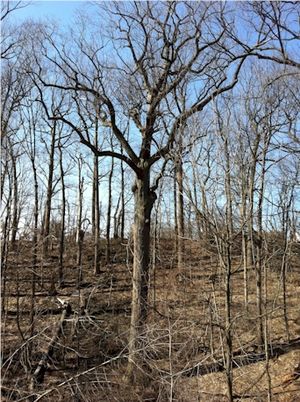
Several parks in the area are managed by the New York City Department of Parks and Recreation. Alley Pond Park is a large wildlife and bird sanctuary on the western waterfront. It's home to the Queens Giant, which is the oldest known tree in New York City. To the east along the water is Udalls Cove, another wildlife sanctuary.
Because northern Douglaston–Little Neck is near the water, many residents enjoy water activities. The Douglaston Yacht Squadron is the local yacht club. They also have a junior program that teaches young people how to sail. This club is part of the Douglaston Club, which is located in George Douglas's original mansion. The Douglaston Club also hosts community events, like Chess championships. Tennis is also a popular sport in the neighborhood.
Southern Douglaston–Little Neck has an 18-hole golf course. It used to be called the North Hills Country Club. This course opened in 1927 and became a public course in the 1960s. The Douglaston Park Golf Course was updated in 2004. It's located on one of the highest points in Queens, offering great views of the Manhattan skyline.
Education and Learning
Douglaston–Little Neck and Bayside have many residents who have gone to college. Most adults (52%) have a college education or higher.
Students in Douglaston–Little Neck and Bayside usually miss fewer school days than in other parts of New York City. Only 5% of elementary school students miss twenty or more days a year. Also, 95% of high school students here graduate on time, which is higher than the city average.
Schools for All Ages
Public Schools
Douglaston–Little Neck has several public elementary schools:
- PS 94 David D. Porter (for grades PK-5)
- PS 98 The Douglaston School (for grades PK-5)
- PS 221 North Hills (for grades PK-5)
- PS 811 Multiple Handicap School of Queens (for grades 1–6), which helps students with physical and mental disabilities.
After elementary school, students go to JHS 67 Louis Pasteur Middle School (grades 6-8). Then, public high school students attend Benjamin N. Cardozo High School in nearby Bayside.
Private Schools
Divine Wisdom Catholic Academy is a private Catholic school for pre-school to 8th grade. The Immaculate Conception Center is located in southern Douglaston. It used to be a college for priests. Now it's a large conference center for church events, language classes, and retreats. It also hosts community meetings.
Libraries for Reading and Research
The Queens Public Library has two branches in the neighborhood:
- Douglaston/Little Neck branch at 249-01 Northern Boulevard
- North Hills branch at 57-04 Marathon Parkway
Getting Around: Transportation
Douglaston–Little Neck has two stations on the Long Island Rail Road's Port Washington Branch. The Douglaston station is at 235th Street and 41st Avenue. The Little Neck station is at Little Neck Parkway and 39th Road. The Little Neck station is near a very busy railroad crossing.
Even though there are no New York City Subway stations nearby, you can take MTA Regional Bus Operations local buses (Q12, Q30, Q36) to connect to the subway. There are also express buses (QM3, QM5, QM8, QM35) that go directly to Manhattan. The n20G bus provides service between the neighborhood and Great Neck.
Two major Long Island highways pass through Douglaston–Little Neck: Interstate 495 (the Long Island Expressway) and the Cross Island Parkway. The Grand Central Parkway forms the southern border of the neighborhood.
Local News
The local newspaper for the area is the Little Neck Ledger. It's part of the TimesLedger Newspapers, which publishes weekly newspapers across Queens.
Famous People from Douglaston–Little Neck
Many well-known people have lived in Douglaston–Little Neck, including:
- Lidia Bastianich (born 1947), a famous chef.
- Mary Carillo (born 1957), a sportscaster and former tennis player.
- Whitey Ford (1928–2020), a baseball player for the New York Yankees and a Hall of Famer.
- George Grosz (1893–1959), an artist.
- Angela Lansbury (1925-2022), a famous actress.
- John McEnroe (born 1959), a famous tennis player.
- Patrick McEnroe (born 1966), also a tennis player.
- Thomas Merton (1915–1968), a monk and author.
- Jean Nidetch (1923–2015), who started Weight Watchers.
- Ginger Rogers (1911–1995), a famous actress and dancer.
- George Tenet (born 1953), who used to lead the CIA.
- Arthur Treacher (1894–1975), an actor.
Douglaston–Little Neck in Movies and TV
This neighborhood has been a filming location for many movies and TV shows:
- Movies like American Gangster, Black Rain, Little Children, and Rabbit Hole were filmed here.
- The Zion Episcopal Church was used in the movie First Reformed and the TV show The Blacklist.
- In the TV show Jessica Jones, Jessica's childhood home was set in this neighborhood.
- Douglaston also appeared in Daredevil season 3.
See also
 In Spanish: Douglaston y Little Neck (Queens) para niños
In Spanish: Douglaston y Little Neck (Queens) para niños


